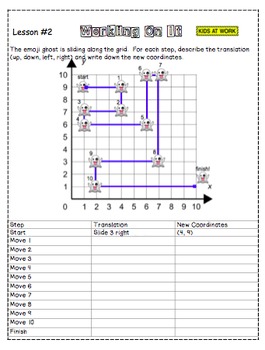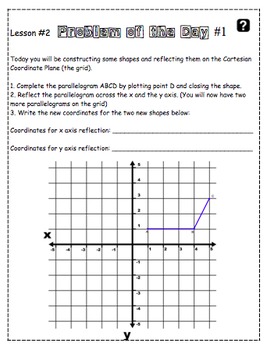Translations, Reflections, Rotations NO PREP
Description
This unit can be printed out into a student booklet to bring independence to your junior learners or shared onto your Google Classroom!
Updated with Answer Key/Guide!
Teach your students everything they need to know about translations, reflections and rotations! In this download you will get a 30 page student booklet, a diagnostic and summative assessment, and six transformation centers. There are 4 three part lessons within the booklet, each including Getting Started activities, working On It practice pages and problems and Reflect and Connect assessments. Each concept (translations, reflections and rotations) is covered in detail. There are a variety of instructional strategies such as: videos, jot notes, shared reading, foldable, problem of the day, multiple choice, fill in the blanks and review centers.
I highly recommend using tracing paper (or tissue ) for the reflections lessons in this unit.
Lessons:
Diagnostic Assessment
Lesson #1: Transformations Introduction
Getting Started: Introduction to the three different types of transformations. Student watch a video about how transformations are used in computer animation and special effects.
Working On It: After watching the video, students create a foldable which outlines the difference between translations, rotations and reflections.
Reflect & Connect: Students identify the emoji movements as either translations, reflection or rotation.
Lesson #2: Translations
Getting Started: Translations (slides). Students watch a video about translations and make jot notes. Students circle examples of translations.
Working On It: Students describe how an emoji ghost translate along a grid and identify the new coordinates of each move.
Reflect & Connect: Students translate a pool to a new location in a backyard, ad describe several other translations.
Lesson #3: Reflections
Getting Started: Students begin by watching a video about reflections. Students practice reflecting a variety of shapes on a grid (using a mirra).
Problem of the Day (2 problems) Students construct a parallelogram and a trapezoid given the coordinates. Students reflect each shape is reflected across the x and y axis and identify the new coordinates.
Reflect & Connect: Students continue to practice reflections across x and y axis.
Lesson #4: Rotations
Getting Started: Students begin by watching a video about rotations. Students review the terms clockwise and counterclockwise and practice showing these directions. Read-aloud: students red about rotations. Specifically, direction, degrees and point of rotation. Students complete a fill in the blanks after the reading to review main points.
Problem of the Day (2 problems) Students rotate a polygon and identify the new coordinates, and students reflect a triangle and determine if the triangle could be rotated to reach the same ending position.
Reflect & Connect: Students complete a multiple choice question to identify 3 clockwise rotations.
Centers: (these are great for review before the summative assessment)
1 – Perplexing Puzzle: Pieces of a puzzle are moved to complete the picture in the fewest steps possible.
2 – Tricky Transformations: 2 multiple choice questions practicing rotations using tracing paper, and following a series of transformations and identifying the ending location.
3 – Border Order: Transform the shape to create a border around a picture. Describe the movements.
4 – Rotation Station: Students rotate a hexagon about a point off of the shape and record its new coordinates.
5 – Transforming Triangles: Students describe how a triangle has been transformed to a variety of positions.
6 – Camping Commotion: Campers move their tents around a campsite. Students describe how 3 tents are moved from one location to another.
Expectations: Identify, perform and describe rotations of 90 and 180 degrees clockwise and counter clockwise (point of rotation inside and outside shape)
Create and analyze designs made by reflecting, translating or rotating a shape.





